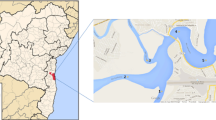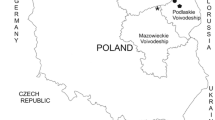Abstract
Trace metals such as Zn, Cu, and Fe are essential for life; differently, no biochemical function is known for Cd. Changes in dietary metal concentrations can cause deficiency or toxicity. Studies on trace elements in cat are lacking. This paper aimed to analyze Zn, Cu, Fe and Cd concentrations in liver and kidney of pathological domestic cat and to isolate metallothionein (MT) in these tissues. It was not possible to explore a possible correlation between metal concentrations and pathologies because the incidence for each of them was too low. Fe was the most abundant metal; in particular, the liver accumulates average Fe concentrations one order of magnitude higher than Zn and Cu, ranging from 66.75 and 1,444.23 µg/g. Significantly, higher levels of Fe were found in the liver of elder animals. Zn concentrations varied between 26.31 and 84.78 µg/g in the liver whereas in the kidney, ranged between 7.69 and 71.15 µg/g. Cu concentrations were between 2.37 and 112.91 µg/g in liver and between 2.12 and 9.85 µg/g in kidney. Cd was the least abundant metal with the exception of the kidney of the oldest cats where it reached a maximum of 13.71 µg/g. Gel-filtration metal distribution profiles from cytosolic extracts revealed the presence of Cd, Cu, Zn thioneins either in the liver or in the kidney. Because tissue samples were taken from pathological cats from different breed and age, care must be taken to use these data as a baseline profile of trace elements in healthy animals. Our results are indicative that for some specimens the feed levels of Fe and Cu could be higher than the optimal dietary intake and in few cats, there was also an exposure to Cd that was counteracted by MT biosynthesis.


Similar content being viewed by others
References
Castillo-Durán C, Cassorla F (2008) Trace minerals in human growth and development. J Pediatr Endocrinol Metab 12(5 Suppl 2):589–601
Vallee BL, Falchuk KH (1993) The biochemical basis of zinc physiology. Physiol Rev 73:79–118
Gaetke LM, Chow CK (2003) Copper toxicity, oxidative stress, and antioxidant nutrients. Toxicology 189(1–2):147–163
Andrews NC (2008) Forging a field: the golden age of iron biology. Blood 112(2):219–230
Martelli A, Rousselet E, Dyckea C, Bourona A, Moulis JM (2006) Cadmium toxicity in animal cells by interference with essential metals. Biochimie 88(11):1807–1814
Kägi JH, Vallee BL (1960) Metallothionein: a cadmium- and zinc-containing protein from equine renal cortex. J Biol Chem 235:3460–3465
Vašák M (2005) Advances in metallothionein structure and functions. J Trace Elem Med Biol 19(1):13–17
Dalton T, Fu K, Palmiter RD, Andrews GK (1996) Transgenic mice that overexpress metallothionein-I resist dietary zinc deficiency. J Nutr 126:825–833
Suzuki KT, Someya A, Komada Y, Ogra Y (2002) Roles of metallothionein in copper homeostasis: responses to Cu-deficient diets in mice. J Inorg Biochem 88(2):173–182
Klaassen CD, Liu J, Choudhuri S (1999) Metallothionein: an intracellular protein to protect against cadmium toxicity. Annu Rev Pharmacol Toxicol 39:267–294
Doong G, Keen CL, Rogers Q, Morris J, Rucker RB (1983) Selected features of copper metabolism in the cat. J Nutr 113(10):1963–1971
Fascetti AJ, Morris JG, Rogers QR (1998) Dietary copper influences reproductive efficiency of queens. J Nutr 128(12 Suppl):2590S–2592S
Fascetti AJ, Rogers QR, Morris JG (2000) Dietary copper influences reproduction in cats. J Nutr 130(5):1287–1290
Henry RB, Liu J, Choudhuri S, Klaassen CD (1994) Species variation in hepatic metallothionein. Toxicol Lett 74(1):23–33
Uriu-Adams JY, Keen CL (2005) Copper, oxidative stress, and human health. Mol Aspects Med 26(4–5):268–298
Madsen E, Gitlin JD (2007) Copper deficiency. Curr Opin Gastroenterol 23(2):187–192
Meertens NM, Bokhove CA, van den Ingh TS (2005) Copper-associated chronic hepatitis and cirrhosis in a European Shorthair cat. Vet Pathol 42(1):97–100
Prohaska JR (1983) Changes in tissue growth, concentrations of copper, iron, cytochrome oxidase and superoxide dismutase subsequent to dietary or genetic copper deficiency in mice. J Nutr 113(10):2048–2058
Evans GW (1973) The biological regulation of copper homeostasis in the rat. Physiol Rev 53(3):535–537
Linz R, Barnes NL, Zimnicka AM, Kaplan JH, Eipper B, Lutsenko S (2008) Intracellular targeting of copper-transporting ATPase ATP7A in a normal and Atp7b−/− kidney. Am J Physiol Renal Physiol 294(1):F53–F61
Thornburg LP (2000) A perspective on copper and liver disease in the dog. J Vet Diagn Invest 12(2):101–110
Haynes JS, Wade PR (1995) Hepatopathy associated with excessive hepatic copper in a Siamese cat. Vet Pathol 32(4):427–429
Fosmire GJ (1990) Zinc toxicity. Am J Clin Nutr 51(2):225–227
Frederickson CJ, Koh JY, Bush AI (2005) The neurobiology of zinc in health and disease. Nat Rev Neurosci 6(6):449–462
Gandini G, Bettini G, Pietra M, Mandrioli L, Carpenè E (2002) Clinical and pathological findings of acute zinc intoxication in a puppy. J Small Anim Pract 43(12):539–542
Chimienti F, Favier A, Seve M (2005) ZnT-8, a pancreatic beta-cell-specific zinc transporter. Biometals 18(4):313–317
Eide DJ (2006) Zinc transporters and the cellular trafficking of zinc. Biochim Biophys Acta 1763(7):711–722
Cook CI, Yu BP (1998) Iron accumulation in aging: modulation by dietary restriction. Mech Ageing Dev 102(1):1–13
Halliwell B, Gutteridge E (1985) Oxygen toxicity, oxygen radicals, transition metals and disease. Mol Aspects Med 8(2):89–193
Rattan SI (2006) Theories of biological aging: genes, proteins, and free radicals. Free Radic Res 40(12):1230–1238
MacKenzie EL, Iwasaki K, Tsuji Y (2008) Intracellular iron transport and storage: from molecular mechanisms to health implications. Antioxid Redox Signal 10(6):997–1030
Brissot P, Troadec MB, Bardou-Jacquet E, Le Lan C, Jouanolle AM, Deugnier Y, Loréal O (2008) Current approach to hemochromatosis. Blood Rev 22(4):195–210
O'Toole D, Kelly EJ, McAllister MM, Layton AW, Norrdin RW, Russell WC, Saeb-Parsy K, Walker AP (2001) Hepatic failure and hemochromatosis of Salers and Salers-cross cattle. Vet Pathol 38(4):372–389
van Geffen C, Savary-Bataille K, Chiers K, Giger U, Daminet S (2008) Bilirubin cholelithiasis and haemosiderosis in an anaemic pyruvate kinase-deficient Somali cat. J Small Anim Pract 49(9):479–482
Shaikh ZA, Jordan SA, Tewari PC (1993) Cadmium disposition and metallothionein induction in mice: strain-, sex-, age-, and dose-dependent differences. Toxicology 80(1):51–70
Danielsson R, Frank A (2009) Cadmium in moose kidney and liver—age and gender dependency, and standardisation for environmental monitoring. Environ Monit Assess 157(1–4):73–88
Jeffery EH, Noseworthy R, Cherian MG (1989) Age dependent changes in metallothionein and accumulation of cadmium in horses. Comp Biochem Physiol C 93(2):327–332
Huff J, Lunn RM, Waalkes MP, Tomatis L, Infante PF (2007) Cadmium-induced cancers in animals and in humans. Int J Occup Environ Health 13(2):202–212
Palmiter RD (1998) The elusive function of metallothioneins. Proc Natl Acad Sci U S A 95(15):8428–8430
Carpenè E, Andreani G, Isani G (2007) Metallothionein functions and structural characteristics. J Trace Elem Med Biol 21(Suppl 1):35–39
Bay BH, Jin R, Huang J, Tan PH (2006) Metallothionein as a prognostic biomarker in breast cancer. Exp Biol Med (Maywood) 231(9):1516–1521
Hinkel A, Schmidtchen S, Palisaar RJ, Noldus J, Pannek J (2008) Identification of bladder cancer patients at risk for recurrence or progression: an immunohistochemical study based on the expression of metallothionein. J Toxicol Environ Health Part A 71(13–14):954–959
Muller P, van Bakel H, van de Sluis B, Holstege F, Wijmenga C, Klomp LW (2007) Gene expression profiling of liver cells after copper overload in vivo and in vitro reveals new copper-regulated genes. J Biol Inorg Chem 12(4):495–507
Minghetti M, Leaver MJ, Carpenè E, George SG (2008) Copper transporter 1, metallothionein and glutathione reductase genes are differentially expressed in tissues of sea bream (Sparus aurata) after exposure to dietary or waterborne copper. Comp Biochem Physiol C Toxicol Pharmacol 147(4):450–459
Suzuki KT (1995) Disordered copper metabolism in LEC rats, an animal model of Wilson disease: roles of metallothionein. Res Commun Mol Pathol Pharmacol 89(2):221–240
Dudley RE, Gammal LM, Curtis D (1985) Cadmium-induced hepatic and renal injury in chronically exposed rats: Likely role of hepatic cadmium-metallothionein in nephrotoxicity. Toxicol Appl Pharmacol 77(3):414–426
Webb M (1987) Toxicological significance of metallothionein. Experientia Suppl 52:109–134
Hispard F, de Vaufleury A, Martin H, Devaux S, Cosson R, Scheifler R, Richert L, Berthelot A, Badata PM (2008) Effects of subchronic digestive exposure to organic or inorganic cadmium on biomarkers in rat tissues. Ecotoxicol Environ Saf 70(3):490–498
Acknowledgments
The authors thank Prof. Giuliano Bettini (Dipartimento di Sanità Pubblica Veterinaria e Patologia Animale) for providing some of the biological samples analyzed in the present paper. This work was supported by RFO grant (Alma Mater Studiorum, University of Bologna).
Author information
Authors and Affiliations
Corresponding author
Rights and permissions
About this article
Cite this article
Andreani, G., Cottignoli, S., Perfetti, B. et al. Trace Elements and Metallothionein in Liver and Kidney of Felis catus . Biol Trace Elem Res 137, 177–189 (2010). https://doi.org/10.1007/s12011-009-8569-5
Received:
Accepted:
Published:
Issue Date:
DOI: https://doi.org/10.1007/s12011-009-8569-5




